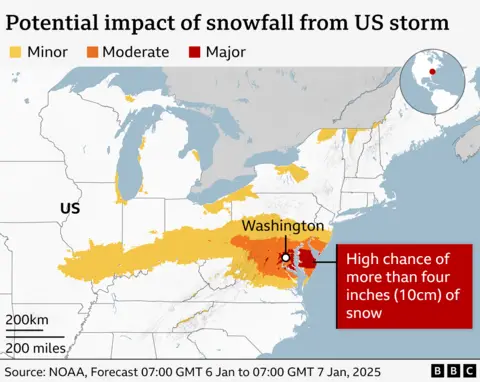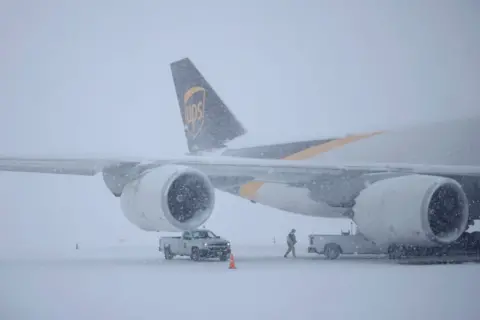What to know about winter storm hitting North America
A huge winter storm has brought snow, ice and and freezing temperatures to a broad swathe of the US, with more than 60 million Americans under weather alerts.
Much of the US is waking up to below freezing temperatures on Monday morning, with some of the coldest conditions expected in Kansas, while the Washington DC area is awaiting unusually heavy snowfall.
Forecasters say the extreme weather - named Storm Blair - is being caused by the polar vortex, an area of cold air that circulates around the Arctic.
As of early Monday morning, 1,400 US flights had been cancelled for the day and 800 delayed, according to FlightAware.com.
A state of emergency has been declared in of Kansas, Missouri, Kentucky, Virginia, West Virginia, Arkansas and parts of New Jersey.
And much of Canada is also under weather alerts, as the blizzard conditions have dumped about a foot of snow (30cm) in places.
Thirty US states, spanning from the middle of the country to the east coast - including major cities such as Washington DC and Philadelphia - are under weather alerts, the National Weather Service (NWS) said.
On Sunday - which was forecast to be the most intense day of the storm - people in affected states saw roads cut off. Schools were shut down on Monday in Virginia, Maryland, Indiana and Kentucky.
Hundreds of car accidents and stranded drivers were reported over the weekend in several midwestern states - including Kansas as well as Indiana, Kentucky and Virginia.
Blizzard warnings have been issued in Kansas, Missouri and Nebraska.
Kansas City is seeing its heaviest snow in 32 years, with more than a foot (30 to 40cm) having come down so far, according to Matthew Cappucci, a senior meteorologist at the weather app MyRadar.
Parts of northern Missouri have already experienced 14in (36cm) of sleet and snow.
The storm began moving toward the US's east coast on Sunday, with parts of Virginia, Maryland, Washington DC and Delaware due to take the brunt.
Washington DC is bracing for heavy snow and bitter cold on Monday, the same day the US Congress is set to meet and formally certify Republican Donald Trump's election as president.
But Republican House Speaker Mike Johnson said the weather would not prevent lawmakers from carrying out their duties. But officials have announced that federal offices in the nation's capital will be closed.
The NWS said the winter storm could bring "the heaviest snowfall in at least a decade", while AccuWeather forecaster Dan DePodwin said: "This could lead to the coldest January for the US since 2011."
He added that "temperatures that are well below historical average" could linger for a week. Temperatures 12-25F (7-14C) below normal are forecast.
Further north, Canadians are also feeling the effects of the polar vortex.
Much of Canada has been under extreme weather alerts, with freezing temperatures spanning the country.
Some areas are also seeing snow squalls - a sudden heavy snowfall accompanied by strong winds.
In the central province of Manitoba, the wind chill could see temperatures plummet to as low as -40C.
Meanwhile, as much as 15in (38cm) of snow was expected in parts of Ontario on Sunday.

Amtrak has also cancelled numerous rail services.
American, Delta, Southwest and United airlines are waiving change fees for passengers because of the potential flight disruptions.
Conditions on roads have deteriorated, with crashes involving lorries and cars, as well as a fire engine rolling over near Salina, Kansas.
"Whiteout conditions will make travel extremely hazardous, with impassable roads and a high risk of motorists becoming stranded," the NWS warned.
Meanwhile, severe thunderstorms capable of producing tornadoes were set to move east from Arkansas and Louisiana into Mississippi and Alabama on Sunday evening, the NWS said.
Private meteorologist Ryan Maue said: "It's going to be a mess, a potential disaster. This is something we haven't seen in quite a while."
How have you been affected by the storm? Share your experiences by following this link.
 Getty Images
Getty Images